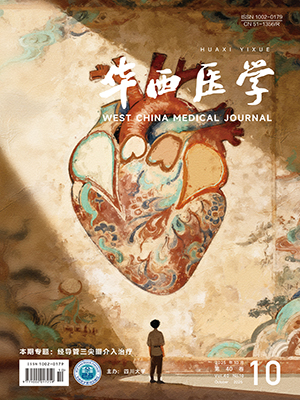| 1. |
国家疾病预防控制局. 2024 年 2 月全国法定传染病疫情概况. 中国病毒病杂志, 2024, 14(3): 232.
|
| 2. |
Biswas S, Kumar R, Shalimar, et al. Viral hepatitis-induced acute liver failure. Indian J Gastroenterol, 2024, 43(2): 312-324.
|
| 3. |
Schweitzer A, Horn J, Mikolajczyk RT, et al. Estimations of worldwide prevalence of chronic hepatitis B virus infection: a systematic review of data published between 1965 and 2013. Lancet, 2015, 386(10003): 1546-1555.
|
| 4. |
Varol M, Licka Dieye N, Zang M, et al. Hepatitis C virus exposure and infection in the perinatal period. Curr Pediatr Rev, 2022, 19(1): 21-33.
|
| 5. |
Viral hepatitis elimination - time to act. Nat Rev Gastroenterol Hepatol, 2024, 21(8): 529.
|
| 6. |
Almeida PH, Matielo CEL, Curvelo LA, et al. Update on the management and treatment of viral hepatitis. World J Gastroenterol, 2021, 27(23): 3249-3261.
|
| 7. |
GBD 2021 Diseases and Injuries Collaborators. Global incidence, prevalence, years lived with disability (YLDs), disability-adjusted life-years (DALYs), and healthy life expectancy (HALE) for 371 diseases and injuries in 204 countries and territories and 811 subnational locations, 1990-2021: a systematic analysis for the Global Burden of Disease Study 2021. Lancet, 2024, 403(10440): 2133-2161.
|
| 8. |
GBD 2019 Europe Hepatitis B & C Collaborators. Hepatitis B and C in Europe: an update from the Global Burden of Disease Study 2019. Lancet Public Health, 2023, 8(9): e701-e716.
|
| 9. |
GBD 2019 Hepatitis B Collaborators. Global, regional, and national burden of hepatitis B, 1990-2019: a systematic analysis for the Global Burden of Disease Study 2019. Lancet Gastroenterol Hepatol, 2022, 7(9): 796-829.
|
| 10. |
余文周, 王富珍, 温宁, 等. 中国深化医疗改革十年免疫规划助力全民健康. 中国疫苗和免疫, 2020, 26(5): 602-606.
|
| 11. |
Migueres M, Lhomme S, Izopet J. Hepatitis A: epidemiology, high-risk groups, prevention and research on antiviral treatment. Viruses, 2021, 13(10): 1900.
|
| 12. |
Liu Z, Shi O, Zhang T, et al. Disease burden of viral hepatitis A, B, C and E: a systematic analysis. J Viral Hepat, 2020, 27(12): 1284-1296.
|
| 13. |
张家玮, 周敏, 苏永健, 等. 基于 Joinpoint 回归模型分析 2005—2021 我国甲型肝炎发病趋势. 华南预防医学, 2024, 50(7): 604-607, 612.
|
| 14. |
国家卫生健康委员会. 国家免疫规划疫苗儿童免疫程序及说明(2021 年版). 中国病毒病杂志, 2021, 11(4): 241-245.
|
| 15. |
邱嘉敏, 曾芳芳, 程琛, 等. 广东省 1990-2019 年急性病毒性肝炎疾病负担分析. 中华流行病学杂志, 2024, 45(3): 365-372.
|
| 16. |
Ouyang G, Pan G, Li Q, et al. Global burden of acute hepatitis E between 1990 and 2019 and projections until 2030. Liver Int, 2024, 44(6): 1329-1342.
|
| 17. |
曾丹艺. 1990-2019 年全球范围急性病毒性肝炎的负担及其与社会经济发展状况的关系. 厦门: 厦门大学, 2022.
|
| 18. |
中国肝炎防治基金会. 成人甲型肝炎疫苗接种专家建议. 中国病毒病杂志, 2023, 13(6): 401-412.
|
| 19. |
刘杰, 郭世成, 伍凤云, 等. 2014-2021 年江西省急性乙型病毒性肝炎流行特征分析. 预防医学, 2024, 36(1): 58-60.
|
| 20. |
Lao TT. Immune persistence after hepatitis B vaccination in infancy - fact or fancy?. Hum Vaccin Immunother, 2016, 12(5): 1172-1176.
|
| 21. |
李生浩, 张黎, 张瑞仙. 1990-2019 年中国丙型病毒性肝炎疾病负担评估. 中国感染控制杂志, 2022, 21(10): 971-976.
|
| 22. |
周梅, 姚丽熙, 吴银莲, 等. 1990-2044 年中国丙型病毒性肝炎相关疾病的疾病负担分析及预测. 中国血吸虫病防治杂志, 2023, 35(5): 476-485.
|
| 23. |
Epstein RL, Espinosa C. Hepatitis C virus in neonates and infants. Clin Perinatol, 2021, 48(2): 343-357.
|
| 24. |
Hajarizadeh B, Cunningham EB, Reid H, et al. Direct-acting antiviral treatment for hepatitis C among people who use or inject drugs: a systematic review and meta-analysis. Lancet Gastroenterol Hepatol, 2018, 3(11): 754-767.
|
| 25. |
Yu S, Wang Q, Wang S, et al. Burden of acute viral hepatitis - China, 1990-2019. China CDC Wkly, 2020, 2(31): 579-586.
|
| 26. |
王朝华. 31 例老年人急性肝炎临床特点分析. 实用老年医学, 2010, 24(1): 83-84.
|
| 27. |
Valamparampil J, Kelly D. Viral hepatitis necessitating liver transplantation in children. Transplantation, 2024, 108(1): 127-136.
|
| 28. |
贾梦山. 2019-2021 年周口市病毒性肝炎病例流行特征分析. 华南预防医学, 2022, 48(8): 967-969.
|
| 29. |
Stawinska-Witoszynska B, Klos J, Moryson W, et al. Trends in the incidence of acute hepatitis B in the Polish population and their determinants. Medicina (Kaunas), 2021, 57(8): 738.
|
| 30. |
袁磊, 张水军. 性别与性激素对乙肝病毒易感性及其免疫应答的影响. 河南医学研究, 2019, 28(10): 1919-1921.
|
| 31. |
Box G. Box and Jenkins: time series analysis, forecasting and control//Mills TC. A very British affair: six britons and the development of time series analysis during the 20th century. London; Palgrave Macmillan UK. 2013: 161-215.
|
| 32. |
Schaffer AL, Dobbins TA, Pearson SA. Interrupted time series analysis using autoregressive integrated moving average (ARIMA) models: a guide for evaluating large-scale health interventions. BMC Med Res Methodol, 2021, 21(1): 58.
|
| 33. |
朱宗元, 于青. ARIMA 模型在我国病毒性肝炎发病率预测中的应用. 中国卫生统计, 2011, 28(1): 65-67.
|
| 34. |
Zhang C, Liu Y, Zhao H, et al. Global patterns and trends in total burden of hepatitis B from 1990 to 2019 and predictions to 2030. Clin Epidemiol, 2022, 14: 1519-1533.
|
| 35. |
Scott N, Sacks-Davis R, Wade AJ, et al. Australia needs to increase testing to achieve hepatitis C elimination. Med J Aust, 2020, 212(8): 365-370.
|
| 36. |
丁勇, 吴静, 武丹, 等. ARIMA 乘积季节模型预测我国戊肝的发病趋势. 南京医科大学学报(自然科学版), 2020, 40(11): 1725-1729.
|
| 37. |
郑慧敏, 薛允莲, 黄燕飞, 等. ARIMA 模型在深圳市法定传染病发病趋势预测的应用. 实用预防医学, 2016, 23(2): 240-243.
|
| 38. |
Huang D, Lai H, Shi X, et al. Global temporal trends and projections of acute hepatitis E incidence among women of childbearing age: age-period-cohort analysis 2021. J Infect, 2024, 89(4): 106250.
|
| 39. |
Su X, Zheng L, Zhang H, et al. Secular trends of acute viral hepatitis incidence and mortality in China, 1990 to 2019 and its prediction to 2030: the Global Burden of Disease Study 2019. Front Med (Lausanne), 2022, 9: 842088.
|




